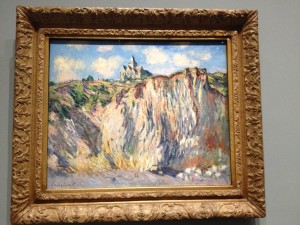I’ve resisted the obvious, but in the end I’ve found it impossible, and so here is a short piece about Monet and Thoreau. There are many shared affinities – water, light, immediate Nature – but the catalyst for me has been a painting Monet did in 1882.
I first saw Église at Varengeville at a small museum during a recent sojourn in Paris. A few days earlier, we had, as seems appropriate for such a viewing, walked a number of miles to reach The Marmottan, another small museum not far from the Bois de Boulogne. There, we had eased through rooms of paintings Monet left to his son, who, in turn, left them to the French people. Unlike the crowded center-Paris museums with their famous Impressionist stock, this old house of a museum had only a few visitors. At one point I found myself alone in an oval room, surrounded by paintings of plants from Monet’s Walden in Giverny; no one else breathed; the air seemed to quiver with color and light.
All of this brought us to the Luxembourg Gardens museum, where I was again amid throngs. Perhaps you have this experience too, but I find myself distracted by people in museums – I often end up spending more time watching people looking at paintings than I do looking at the art itself. I think of it as the “ert” watching the inert, or the other way around.
Anyway, amid the crush, I reached three paintings labelled “Effet du Matin,” and the mention of morning and its effects rang, as it always does, the little Thoreau bell in my mind. I began to study Église at Vargengeville, and then, even given light jostling, I was alone in its colors and light.
The church sits atop a high cliff that falls to what seems to be ocean, and it – the church – looks like a hat sizes too small for the cliff it tops. That stone is the painting’s real subject, I think, and it is alive with morning light, its streaks of color rising from what looks like kindled flame at the painting’s base. The eye is drawn to the cliff and lifted; the heart is uplifted too.
That seems the effect of light in this best season of the day, the time of awakening. Even after we left the museum, I kept returning to Effet du Matin, just as, given a morning mind and luck, we see fresh light each day.


